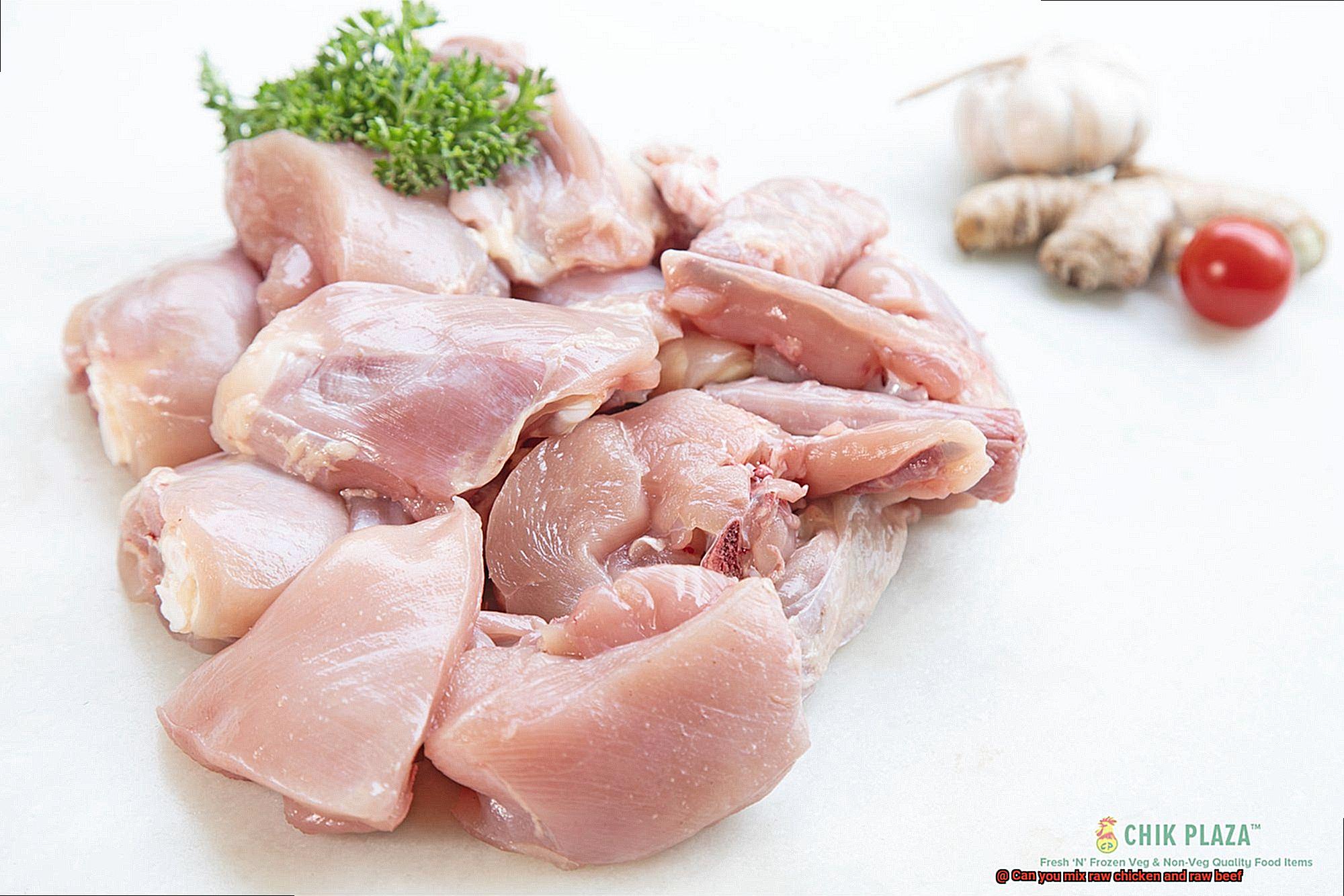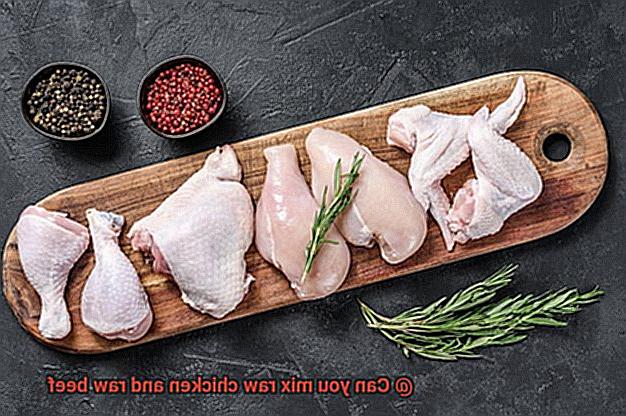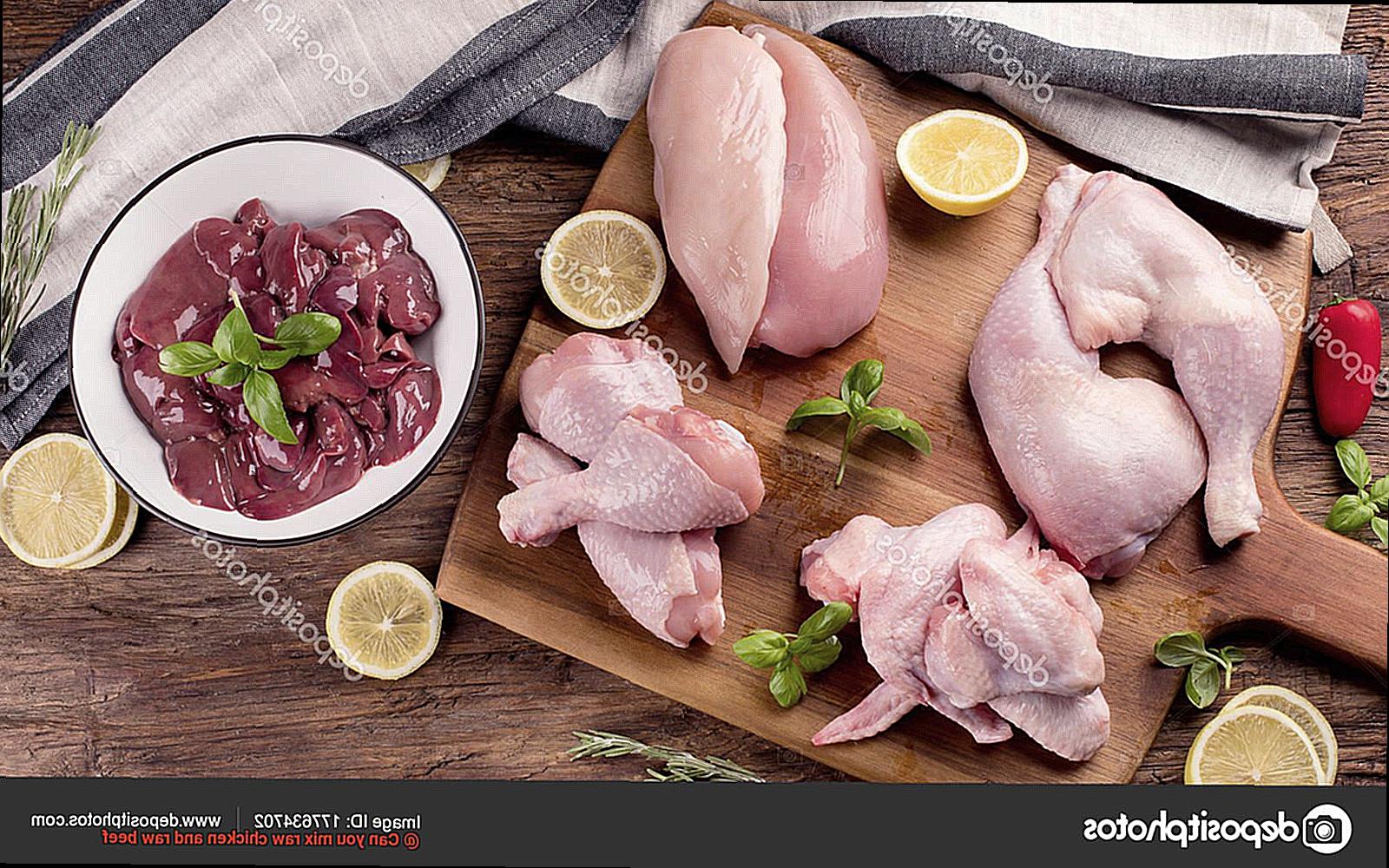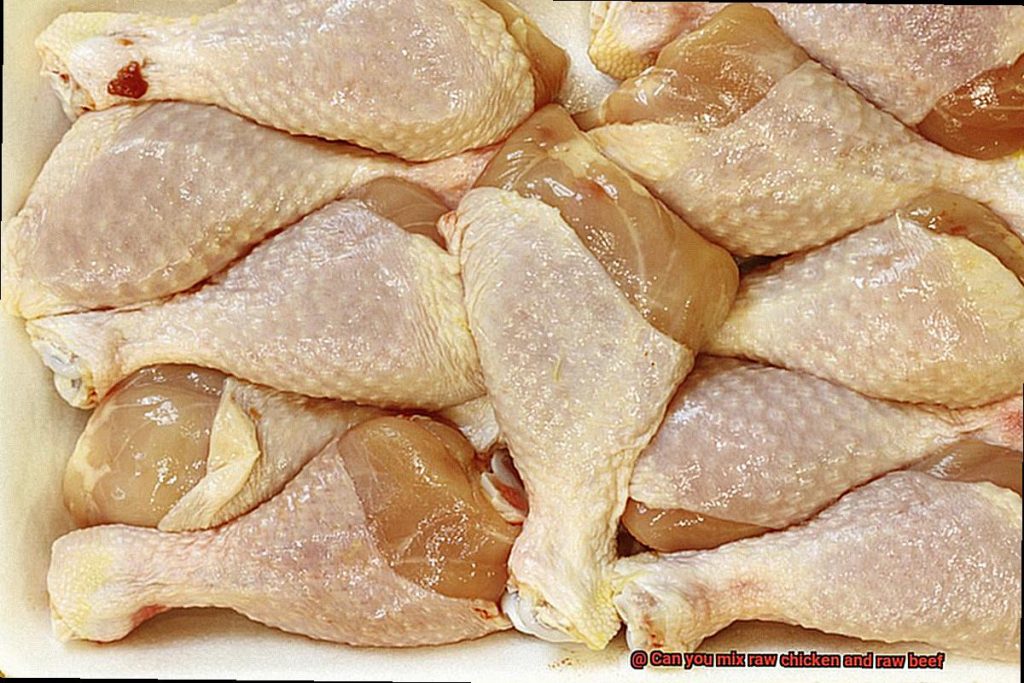Do you have a hankering for some protein but only have chicken and beef in your fridge? The thought of combining them into one dish may seem tempting, but can you mix raw chicken and raw beef? Unfortunately, the answer is not as simple as a yes or no.
On one hand, mixing different meats can create a symphony of flavors and textures that tantalize the taste buds. However, on the other hand, it can lead to serious health consequences. Raw meat is often contaminated with bacteria such as salmonella, E. coli, and campylobacter – causing foodborne illnesses like diarrhea, vomiting, and abdominal pain. Cross-contamination can also occur when utensils, cutting boards, and hands that have come into contact with raw meat are not properly washed before handling cooked or ready-to-eat foods.
So what’s the solution? It’s best to err on the side of caution and avoid mixing different raw meats altogether. Cook them separately to their recommended temperature by the USDA: chicken to 165°F and beef to 145°F for medium-rare or 160°F for medium. Remember to wash your hands and surfaces thoroughly before and after handling raw meat. Never place cooked meat on a plate that previously held raw meat.
By following these safety guidelines, you can enjoy your delicious dishes without any worries about contamination.
Contents
What is the Risk of Mixing Raw Chicken and Raw Beef?
These meats carry a variety of bacteria that can cause severe foodborne illnesses, such as salmonella and E. coli, and when mixed, the risk of cross-contamination skyrockets.
Raw chicken is notorious for carrying harmful bacteria, such as salmonella and campylobacter, which can easily spread to other meats if they come into contact. On the other hand, raw beef may contain E. coli, which can also lead to severe illness if not handled properly.
To reduce the risk of illness, it is highly recommended to keep raw chicken and beef separate by using separate cutting boards, utensils, and containers. Additionally, make sure to wash your hands and any surfaces that come into contact with raw meat carefully with soap and water before moving on to the next ingredient or task.
Aside from the health risks, mixing raw chicken and beef can also impact the flavor and texture of the meat. Both meats have different cooking times and temperatures, meaning that one meat may be overcooked or undercooked if they are mixed together.
Why Should Raw Chicken and Raw Beef be Kept Separate?
While the idea may sound like a great way to add some excitement to your meal, it can also be a recipe for disaster. Raw chicken and beef should always be kept separate to prevent the risk of foodborne illness.
Why is it so important to keep raw chicken and beef separate, you ask? Well, let’s explore.
Firstly, both raw chicken and beef can contain harmful bacteria such as E. coli, Salmonella, and Campylobacter that can cause serious health problems if consumed. These bacteria can easily transfer from one type of meat to another if they come into contact with each other or with surfaces that have been contaminated.

Secondly, raw chicken and beef require different cooking temperatures to ensure they are safe to eat. Chicken needs to be cooked to an internal temperature of 165°F to kill any harmful bacteria, while beef only needs to be cooked to 145°F. If the two meats are mixed together, it can make it difficult to ensure that both types of meat are cooked to their respective safe temperatures.
Lastly, raw chicken and beef have different handling requirements. Chicken should always be handled with care to avoid cross-contamination since it is a common carrier of Salmonella bacteria. Similarly, raw beef should also be handled carefully to avoid contamination with E. coli bacteria.
To reduce the risk of foodborne illness, it is essential to keep raw chicken and raw beef separate in the refrigerator. It is recommended that you use separate cutting boards and utensils for each type of meat. Also, wash your hands thoroughly after handling either type of meat. By taking these precautions, you can help ensure that your meals are safe and healthy for you and your family.
In summary, keeping raw chicken and beef separate is crucial for your health and safety. Here are some key points to remember:
- Raw chicken and beef can contain harmful bacteria that can cause serious health problems.
- Raw chicken and beef require different cooking temperatures to ensure they are safe to eat.
- Raw chicken and beef have different handling requirements.
- Always keep raw chicken and beef separate in the refrigerator.
- Use separate cutting boards and utensils for each type of meat.
- Wash your hands thoroughly after handling either type of meat.
How to Avoid Cross-Contamination when Preparing and Cooking Meats
Cross-contamination is a major concern when preparing and cooking meats. It can cause harmful bacteria to spread from one type of meat to another, leading to food poisoning. To avoid cross-contamination, it is essential to follow proper food safety practices. Here are some tips on how to avoid cross-contamination when preparing and cooking meats:
Wash your hands thoroughly:
One of the most crucial steps to avoid cross-contamination is washing your hands thoroughly before and after handling any type of meat. Make sure to scrub your hands with warm water and soap for at least 20 seconds. This will help prevent the spread of bacteria.
Use separate cutting boards and utensils:

Using separate cutting boards and utensils for each type of meat you are preparing is essential. This will prevent the transfer of bacteria from one type of meat to another. It is also necessary to clean the cutting boards and utensils thoroughly after use.
Keep raw meat refrigerated:
Raw meat should always be kept refrigerated until it is ready to be cooked. This helps slow down the growth of bacteria and reduces the risk of contamination. It is advisable to store raw meats on the bottom shelf of the refrigerator, away from other foods.
Cook meats to the appropriate temperature:
Using a food thermometer is vital to ensure that meats are cooked to the appropriate internal temperature. This will help kill any harmful bacteria that may be present in the meat. Different types of meat have different cooking temperatures, so make sure you know the right temperature for each type.
Avoid using the same plate or utensils:
It is important to use separate plates and utensils for cooked and raw meats. Using the same plate or utensils can lead to cross-contamination, allowing harmful bacteria from raw meat to spread onto cooked meat.
Cleaning Tips for Utensils, Cutting Boards, and Containers
When it comes to handling raw chicken and beef, maintaining a clean and sanitary workspace is crucial. Cross-contamination is a significant risk when bacteria from one type of food comes into contact with another type of food, increasing the risk of foodborne illness. In this blog post, I will explain the importance of cleaning and sanitizing utensils, cutting boards, and containers when handling raw chicken and beef.
Separate Cutting Boards
Using separate cutting boards for raw chicken and beef is recommended to avoid cross-contamination. Color-coded cutting boards can be helpful in distinguishing between different types of meats.
After each use, cutting boards should be thoroughly washed with hot soapy water and then sanitized with a solution of one tablespoon of bleach per gallon of water. This step is essential in ensuring that any bacteria on the surface of the cutting board is eliminated.
Clean Utensils

Utensils such as knives, tongs, and spatulas must also be washed with hot soapy water after each use and then sanitized in the same bleach solution as the cutting boards. It is crucial to pay special attention to any crevices or joints where bacteria can accumulate. If you’re handling both raw chicken and beef at the same time, make sure to use separate utensils for each type of meat. This will prevent any bacteria from transferring between the two.

Properly Clean Containers
Containers used for marinating or storing raw chicken and beef should be made of non-porous materials such as glass or stainless steel. Plastic containers can absorb bacteria and become difficult to sanitize properly. Containers should be thoroughly washed with hot soapy water and then sanitized in the bleach solution.
Reusing containers or bags that have not been properly cleaned after coming into contact with raw chicken or beef can lead to cross-contamination.

Frequent Handwashing
Washing hands frequently during the food preparation process is crucial in preventing cross-contamination. Hands should be washed with hot soapy water for at least 20 seconds before and after handling raw meat. This step is essential in reducing the risk of spreading bacteria from your hands to other surfaces or foods.
Avoid Cross-Contamination
By following these cleaning tips for utensils, cutting boards, and containers, you can help prevent cross-contamination and ensure that your grilled meats are safe and delicious for everyone to enjoy. Cross-contamination can occur when bacteria from one type of food comes into contact with another type of food. It can be avoided by following the proper cleaning and sanitizing steps outlined above.

Different Cooking Times for Different Meats
Mixing raw chicken and raw beef together may seem like a time-saver, but it can quickly turn into a recipe for disaster.
Why is that, you ask? Chicken and beef require different cooking times due to their unique characteristics. For example, chicken needs to be cooked to a higher internal temperature than beef to kill harmful bacteria. The safe internal temperature for chicken is 165 degrees Fahrenheit, while beef can be cooked to a lower temperature of 145 degrees Fahrenheit for medium rare or 160 degrees Fahrenheit for medium.
Cooking both chicken and beef together is not recommended as it can be challenging to ensure that both meats are cooked to their proper internal temperatures without overcooking one or the other. The result could be undercooked chicken, which can cause foodborne illness, or overcooked beef, which can lead to a tough and dry texture.
If you do choose to cook chicken and beef together, keep a close eye on the internal temperature of each meat and adjust the cooking time accordingly. Using a meat thermometer is an excellent way to ensure that both meats reach their safe internal temperatures without overcooking or undercooking either one.
To avoid cross-contamination, use separate cutting boards, wash utensils thoroughly, and frequently wash your hands to prevent the spread of bacteria from one type of food to another.
Harmful Bacteria Found in Raw Chicken and Raw Beef
These meats are known to harbor harmful bacteria that can cause foodborne illnesses, including Salmonella, E. coli, and Campylobacter. Here’s what you need to know about these bacteria and how to keep yourself safe:
Salmonella is a bacterium commonly found in raw poultry like chicken, but it can also be present in beef. This resilient bacteria can survive in a range of environments and is often spread through contaminated food or water. Symptoms of Salmonella infection usually appear within 6 to 72 hours after exposure and can last up to a week. These symptoms include vomiting, nausea, diarrhea, abdominal cramps, and fever.
E. coli is another common bacterium found in raw beef, particularly ground beef. While less common in raw chicken, it can still be present. The symptoms of E. coli infection are severe, including intense stomach cramps, diarrhea (often bloody), and vomiting.
Campylobacter is a bacterium frequently found in raw poultry like chicken and sometimes in beef as well. Symptoms of Campylobacter infection may include diarrhea (often bloody), fever, nausea, and stomach cramps.
So how can you minimize the risk of harmful bacterial contamination in your meat dishes? It all starts with proper handling. Wash your hands thoroughly before and after handling raw meat, keep raw meat separate from other foods during preparation and storage, cook meat to the appropriate temperature (165°F for chicken, 160°F for ground beef), and store cooked meat correctly to prevent bacterial growth. It’s also crucial to avoid cross-contamination by using separate cutting boards and utensils for raw meat and other foods.
Food Safety Habits to Follow When Grilling
Mixing raw chicken and beef on the grill may seem like a time-saver, but it can put your health at risk. As an expert in this field, I have compiled some essential food safety habits to follow when grilling that will keep you and your loved ones safe from harmful bacteria.
Firstly, keeping raw meats separate is crucial. It’s recommended to prepare chicken, beef, and any other meats separately to avoid cross-contamination. This means using separate plates, cutting boards, and utensils. The goal is to prevent spreading bacteria that could cause illness.
Secondly, use separate utensils and cutting boards for each type of meat. This practice helps prevent harmful bacteria from transferring between meats. It may seem like a small detail, but it can make a significant difference in reducing the risk of foodborne illness.
Thirdly, always wash your hands before handling raw meat and after touching it. Proper hand washing is paramount in preventing cross-contamination. Use soap and warm water for at least 20 seconds to get rid of any germs on your hands.
Lastly, cook meats to the correct temperature. Use a meat thermometer to check the internal temperature of your meats. Chicken should be cooked to 165°F and beef should be cooked to 145°F for medium-rare or 160°F for medium. This ensures that all harmful bacteria are destroyed before consuming your delicious grilled meal.
iP5ohUddFOY” >
Conclusion
In conclusion, mixing raw chicken and raw beef is a recipe for disaster. While the thought of creating a unique dish by combining both meats might sound appealing, the risk of cross-contamination and foodborne illnesses is simply too high. Raw chicken and beef are notorious carriers of harmful bacteria such as salmonella, E. coli, and campylobacter that can wreak havoc on your health if not handled with care.
To ensure your safety when handling these meats, it’s crucial to cook them separately to their recommended temperature, use separate cutting boards and utensils for each type of meat, and wash your hands and surfaces thoroughly before and after handling raw meat. It’s also important to note that different meats have varying cooking times; chicken requires a higher internal temperature than beef to kill off any harmful bacteria.
By following essential food safety habits like keeping raw meats separate, using separate utensils and cutting boards for each type of meat, washing hands thoroughly before handling raw meat, and cooking meats to the correct temperature when grilling, you can prevent cross-contamination and enjoy safe and delicious meals.






